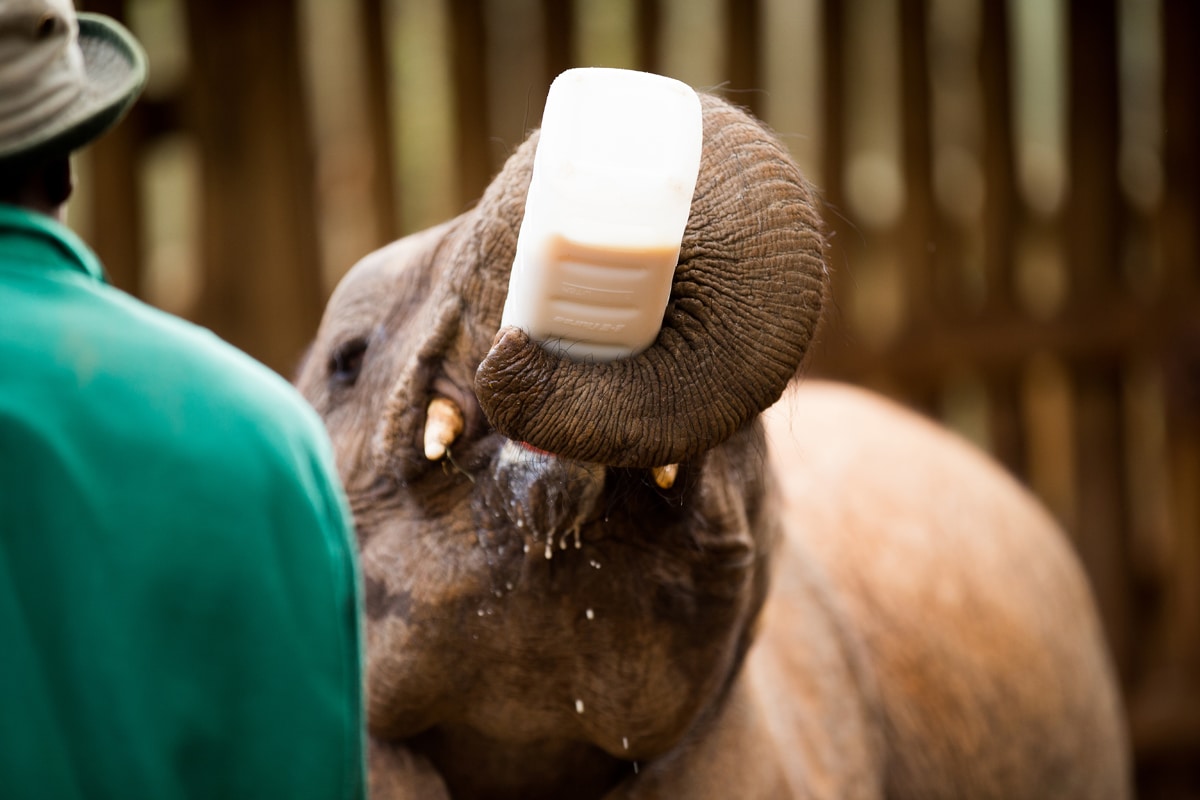These conservation safaris go beyond the “Big 5” excursion, taking travelers across the world to view and help protect exotic wildlife. Here’s how.
8 Outstanding Conservation Safaris Around The World

Food, wine & culture for the ethical traveler

These conservation safaris go beyond the “Big 5” excursion, taking travelers across the world to view and help protect exotic wildlife. Here’s how.

Learn how one recipe sharing platform works to support women in the culinary industry & give to charity while sharing tasty meals!

By Jo-Anne Bowen
A spark of excitement fills the air and all eyes are on the horizon.
Soon, a faint rustle is heard.
Then, at the top of the mound, we see the first elephant baby.
Soon two other orphan elephants follow.
They are here for their mid-morning delight:
A giant bottle of milk and some frolicking in the mud!
This is the daily 11 am routine at the Sheldrick Wildlife Trust’s Nairobi Nursery in Kenya.
Psst, don’t forget to pin this post! It’s an easy way to help this project that is working to save orphaned baby elephants:
The Orphans’ Project is part of the Sheldrick Wildlife Trust, a not-for-profit established in 1977 by the late Dr. Dame Daphne Sheldrick in memory and to honor her husband David Sheldrick, the founder, and warden of Tsavo National Park.
The goal:
To protect and preserve wildlife and habitats in Kenya, for the betterment of all species.
Diving deeper, the Orphan’s Project rehabilitates orphaned elephants and rhinos back into the wild.
Want to help rehabilitate orphan #elephants and #rhinos in Africa back into the wild? Read this. Click To TweetThe Trust holds the distinction of being the most successful orphaned elephant rescue in the world — over 230 orphaned elephants have been successfully hand-raised.
Their work is pioneering in East Africa. For instance, they were the world’s first organization to “successfully hand-raise orphaned milk-dependent elephants and reintegrate them back into the wild through its Orphans’ Project”.
If you love ethical wildlife vacations or are interested in learning how to visit and/or adopt a baby elephant in Kenya, this will absolutely be a must-visit on your trip to Africa.

These baby elephants are lost, abandoned and/or orphaned.
Reasons vary and fall into several categories:
The first reason, accidents, might include a young elephant falling in a well or a mother dying from an injury.
Lack of water might result in the mother dying from drought — especially in the semi-desert areas.
Human encroachment, the third reason, might include the baby being separated from the elephant family by humans or humans encroaching on migration paths.
Then there is animal poaching, a huge problem in Africa, with Kenya being no exception. Side note, the issue is so large, Kenya has rhino guardians that risk their lives to help save local wildlife from poachers, though having the guardians is also a testament to the strides Kenya has made in protecting wildlife.
In terms of elephants, it is estimated that over 25,000 of these emotional creatures are killed each year.
Poachers kill the mother and the baby is left as an orphan.
In the fall, there were 21 “residents” at The Trust’s Nairobi Nursery.

Each baby has a name, often inspired by the region where they were found.
They spend their days browsing together and are divided into two groups for feeding, depending on age, with around 18 years being the dividing line. At around three years of age, the orphans are moved to one of three Reintegration Units in Tsavo National Park.
The Sheldrick Wildlife Trust website also gives full biographies of the baby orphans and introduces the newest resident, Larro.
Good news:
In December, three orphans were moved from the Nursery to one of the Reintegration Units in Tsavo East National Park, where they began the journey of returning to the wild. You can read more about the beautiful story here.
Elephant babies are much like human babies:
They need food, shelter, “clothing”, touch and toys for stimulation.
For nutrition, elephant babies are dependent on milk for their first few years.
Up to between four-to-six months, they have no teeth and thus need milk to survive. Even after they have begun browsing they need milk to sustain their growth and development.
Once they reach about six years of age they’re gradually weaned off, as the elephant starts to ingest more of nature’s vegetation.
How beautiful are these orphan baby elephants in #Kenya? Check them out + learn how to help. #wildlife Click To TweetWhen first found, the babies are often traumatized and need touch and security.
In fact, the Keepers sleep with the youngest babies day and night. About 18 months and over, a Keeper sleeps in every other stockade, or every three stockades, still ever present.

In the wild, a baby stays under its mother’s tummy for a year.
During that time, the mother touches it with her trunk every five-to-ten minutes, giving it reassurance and love.
The Keepers replicate this by encouraging the baby orphan to stay close and snuggle often.
The babies spend their day in the natural environment of the Nairobi National Park so they grow in a natural habitat, socialize with one another and further develop the closeness and “family” bonds.
At dusk, security is provided at the stockade.
At 5pm, the orphans return to the security of the shelter.
“Clothing” consists of blankets when the orphans are young and need warmth and also natural mud baths to protect elephant skin from the sun.
The shelter has a variety of toys around the feeding station.
Toys for young elephants consist of natural toys like logs and branches and also more human toys like balls and rubber tires.

All orphans begin in Nairobi, where the goal of rehabilitation to the wild is first put into action.
Rehabilitation takes place at one of their three Reintegration Units in Tsavo East National Park and Kibwezi Forest.
Both are huge areas with plenty of vegetation to ensure the elephant’s survival. In fact, Tsavo National Park is the largest in Kenya and has the largest population of elephants in the country.
The journey doesn’t end with the first days of rehabilitation as it takes between five-to-ten years for orphan elephants to make friends amongst the wild elephant herds, and the herds of ex-orphans too.
They also need to learn to live more independently.

The elephants remain dependent on the dedicated Keepers at these units for a number of years.
As some elephants are growing and becoming wild, there are a number of still young and dependent elephants there that are not ready yet — they move elephants in groups together from the Nairobi Nursery after most rainy seasons — so there are always more babies moving up the ranks.
KWS Central Workshop entrance, Magadi Road, Nairobi National Park, Kenya.
Open 11 am to noon daily, except Christmas Day.
During this time, one of the keepers gives an educational talk describing the orphans and the workings of the site.

You will see the orphans being fed from gigantic milk bottles and you will chuckle as they frolic in the mud.
Then the Keepers encourage the orphan elephants to wander along the fence lines, so you can touch them if the elephant allows you to.
Want to see and help #wildlife? You must add this #Africa experience to your bucket list. Click To TweetSuggestion:
Arrive early in order to be near the front of the line so that you can be right next to the rope cordon during the visit.
This experience is a highlight of a trip to Kenya and not to be missed!

For only $50 yearly, you can foster a baby elephant orphan.
This also makes a nice gift for someone.
Foster parents also have another benefit:
They can make a 5pm appointment, upon availability, to view the orphan elephants returning to the stockade for the night.
This appointment must be made in advance.
Contact The Trust at [email protected].

Click here for their:
This allows you to stay educated about what is going on with the Sheldrick Wildlife Trust and their orphaned elephants, and share important, potentially life-saving information with your community.
Check out also the Sheldrick Wildlife Trust Shop for everything to do about elephant orphans from canvas tote bags, watercolors of the orphans, branded clothing, calendars, and elephant charms.
Ivory is often used to make jewelry, while elephant legs and feet are used for furniture.

The Sheldrick Wildlife Trust does not offer volunteer opportunities.
Why?
Because one of their aims is to employ as many Kenyans as possible.
Unemployment in the country is very high, so this is another way The Trust enriches the community.
That being said, there are other ways to volunteer.
Help #EndPoaching and save African #wildlife. Here is how. Click To TweetConsider volunteering for the Sheldrick Wildlife Trust USA. For information, email [email protected].
Another way you can help:
Campaign for wildlife in your local area.

Besides raising orphan baby elephants, The Trust also cares for baby orphan rhinos, runs anti-poaching and de-snaring units, operates mobile vet units and Sky Vets.
A small snapshot of the incredible impact they’ve had:
More information may be found on their website here.
References:
Want to help orphaned elephants? Help educate your community and share this post on Pinterest!
PIN
In this Lake Atitlan travel guide, you’ll learn how to visit the culturally-rich village of Santa Catarina Palopó, which is being transformed into an immersive work of art — with a social good twist!

Want to volunteer in Guatemala, or at least support social good projects? Here’s how to get involved with one education-focused NGO that’s truly making a difference for local youth.

Jewelry that gives back to charity is a great way to be stylish and do good. Check out how to help empower displaced women in Istanbul through jewelry.

Ocoa Bay is the Dominican Republic’s first major vineyard plus eco- and socially-conscious resort. It’s a must-do for visitors to the island country!

Rwandan Genocide Survivors are using art to help educate young locals and visitors. Read more about their story, and how you can visit and help.

The Lynnhaven from Pleasure House Oysters, once known as the best in the world and coveted as far away as Europe and Russia, is making a comeback.

Latin America’s first digital island is Ometepe in Nicaragua, with every student on the island having their own laptop. Here’s how (and why it matters).